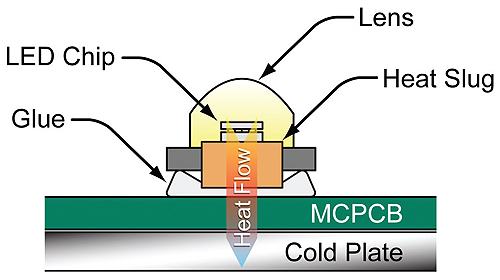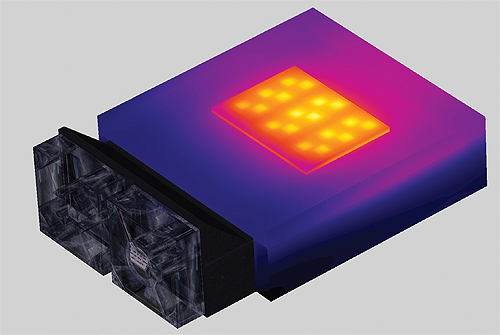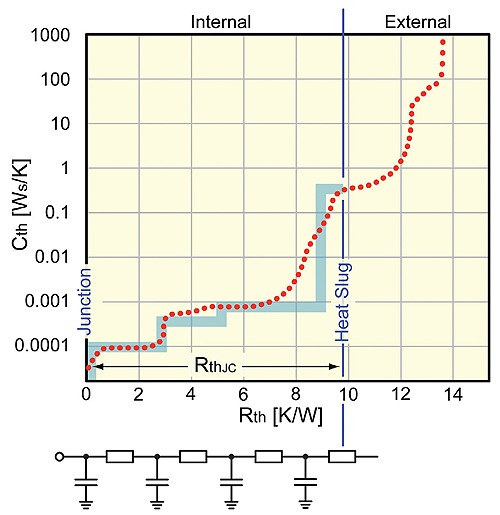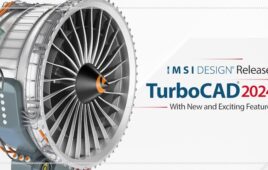By Andras Poppe, Mentor Graphics, Mechanical Analysis MicReD, Budapest, Hungary
Amid all the promotion of solid-state superlatives – from data rate to feature size to LED light output – junction temperature is rarely discussed. That is because junction temperature (TJ) is an undesired but unavoidable side effect of high currents and switching speeds. A p-n junction, whether it is one of millions on a CPU chip or the only one within a power LED, generates heat. In the past two decades the industry has seen heat dissipation increase by orders of magnitude. While faster is better, faster is also hotter.

This illustration shows the heat flow path from a power LED. Thermal measurements can help designers determine which types of interface materials will best transport heat and meet system design goals.
These facts point toward the need of a thorough grasp of thermal behaviors at the chip level, thermal interface materials (TIMs), and heat sinks. True understanding comes with physical measurements performed on actual devices. There are at least 10 reasons to include thermal measurements as a routine step in any electronic component or system design process. Here are the first five.
Insurance against premature product failures
Junction temperature measurements made with tools designed for the purpose of delivering accurate readings of TJ values. Quantifying TJ is part of a due diligence regime that ensures a product design will not fail prematurely. It can help you detect unforeseen high TJ levels and either decrease the current driving the device or select a different component. This action forestalls failures that might occur later.
Navigating the complete heat flow path
Measuring the junction temperature transient that occurs when switching a device on or off produces useful information. Measurements that produce ΔTJ (t) readings can observe the heat flow path far beyond the heat-producing junction. This assumes that the temperature transient measurement is done with sufficient accuracy and resolution and rigorous post-processing of the data.
It is almost always necessary to remove heat from the junction and guide it to a dispersing medium – usually the ambient environment. Using thermal transient measurements, you can check if the proper material is used to serve this purpose. Thermal measurements can help you make sure you select from a range of materials, components, and interface components and fine-tune each element to best fulfill system design goals.

This images shows surface temperature distribution of an IGBT device mounted on air cooled fins. For this simulation, the Mentor Graphics FloTHERM CFD tool used a compact model derived from thermal measurements and cumulative structure functions.
Developing compact models for simulation
Compact models provide a medium that preserves proprietary component information while delivering performance characteristics the recipient can use to model the device in the application. It starts with a cumulative structure function graph derived from thermal transient measurements. As heat travels away from its source (a junction), it encounters thermal resistances (Rth) and capacitive attributes.
A thermal measurement device can perform measurements to support steady-state modeling. A single thermal resistance value known as RthJC, where the “JC” denotes “junction-to-case,” suffices. If a dynamic compact model of the LED package is needed, the simple RthJC resistance value must be replaced by a proper model of the thermal impedance of the entire junction-to-case heat flow path.
A step-wise approximation of the cumulative structure function can be used to derive a set of lumped thermal resistance and thermal capacitance values for a Cauer-type ladder model spanning several stages.
Refining and optimizing library models
Most modeling environments include a library of canned models implemented with the RC network methods already described. But library models rarely reflect the imperfections that can arise in real-world components. Mating surfaces may not be flat, glue or grease applications may be uneven, or materials may suffer from the effects of tolerance stacking. Models may be outdated or inaccurate.
These unforeseeable issues can affect actual thermal characteristics. To avoid this scenario, make rigorous thermal measurements on sample devices to ensure that library models are as accurate as they claim to be, and to provide data to support any necessary refinements to the models. Some modern tools offer temperature resolution at least 10 times better than legacy measurement systems.

In the RC model of the junction-to-case path, each resistor or capacitor symbolizes a real physical feature with a now-qualified value.
Complying with emerging industry standards
While data rates and other characteristics specific to the picosecond and device packaging is subject to stringent compliance requirements, the science of thermal specification is not nearly as advanced. The interpretation of what is important, heat-wise, is largely left to the component end-user.
Thermal standards for measuring individual so-called “steady-state thermal metrics” have existed for decades; the classical JEDEC JESD 51 series is just one example. Practical proposals for measuring and expressing thermal transient characteristics are emerging for example under the aegis of JEDEC. Among recent developments, the JEDEC JC-15 committee has addressed transient methods for junction-to-case thermal resistance measurements in power semiconductors and in November 2010 they published the JESD51-14 standard titled “Transient Dual Interface test Method for the Measurement of the Thermal Resistance Junction to Case of Semiconductor Devices.” This new method is based on thermal transient measurements and structure functions, which deliver much higher repeatability for the RthJC measurements than do the classical steady-state methods. New standards are being worked on for LED thermal measurements in the JEDEC JC-15 committee and in different technical committees of CIE there is extensive work regarding LED optical testing including thermal aspects as well.
In addition, single-die thermal metrics are being extended to encompass multi-die packages (such as stacked die) or SiP with lateral arrangements. Thanks to these trends in standardization, thermal measurements (including thermal transients) are likely to become a routine part of almost every design project that uses semiconductor components.
Mentor Graphics
www.mentor.com
::Design World::
Filed Under: Software • FEA, Software • simulation, ENGINEERING SOFTWARE





Tell Us What You Think!